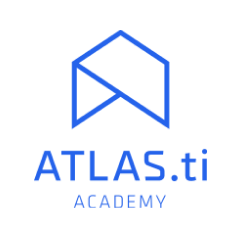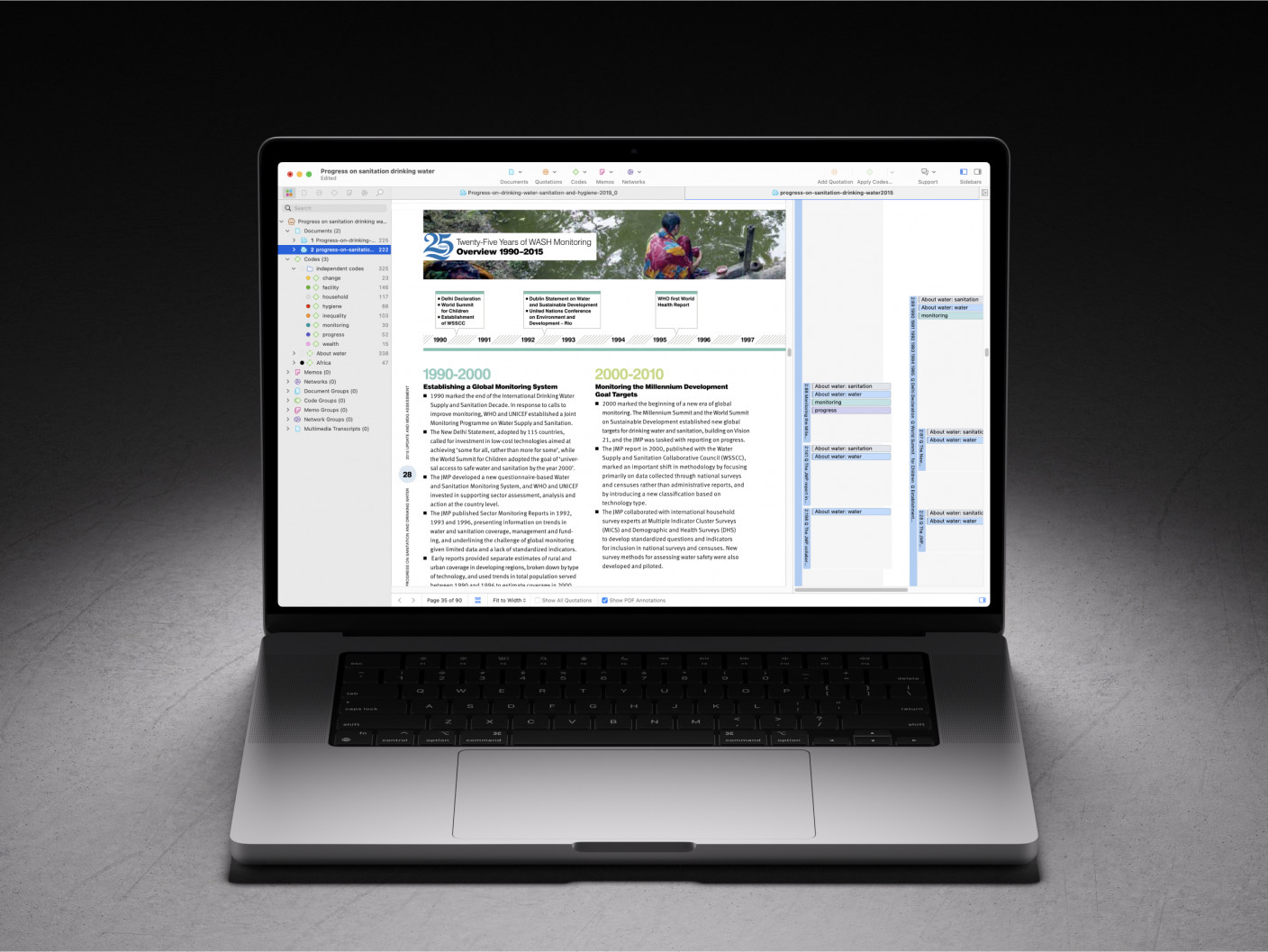- Handling qualitative data
- Transcripts
- Field notes
- Memos
- Survey data and responses
- Visual and audio data
- Data organization
- Data coding
- Coding frame
- Auto and smart coding
- Organizing codes
- Qualitative data analysis
- Content analysis
- Thematic analysis
- Narrative research
- Phenomenological research
- Discourse analysis
- Grounded theory
- Deductive reasoning
- Inductive reasoning
- Inductive vs. deductive reasoning
- Qualitative data interpretation
- Qualitative data analysis software
- How to cite "The Ultimate Guide to Qualitative Research - Part 2"
- Thematic analysis vs. content analysis
Research memos
Depending on who you ask, a memo is or isn't research data. On the one hand, a memo is not data because it's not directly based on what you see or hear. On the other hand, a memo is data because it ultimately informs and shapes the knowledge generated through data analysis.

Either way, memo writing is a key element of a rigorous qualitative research study. As the researcher is the most important part of the data collection process, even a memo as short as one page can be helpful in providing a more focused analytical lens for your study.
What is a research memo?
A research memo, also known as an analytical or reflective memo, is an integral part of the qualitative research process. It is a written record where researchers document their thoughts, interpretations, and reflections about the data collected during the research process. The concept of using short writings to reflect on data collection was widely introduced by grounded theory but has since been incorporated into various qualitative methods due to its effectiveness in fostering a deeper understanding and ensuring rigor in analysis.
Unlike formal research reports that are typically intended for a target audience, memos are internal documents intended for the researchers themselves. They capture the researcher's thought process and help in tracking the progression of ideas, thus serving as a window into the mental workspace of the researcher.
What is the purpose of memoing in qualitative research?
The primary purpose of memoing in qualitative research is to foster reflexivity and analytical thinking during the data collection and analysis processes. This is achieved by encouraging researchers to engage deeply with their study, reflect on their thoughts, and document their interpretations.
In the early stages of the research process, memos help researchers articulate their initial impressions and tentative propositions. As your study progresses, memoing facilitates constant comparison, wherein new data is continuously compared with previous data and existing interpretations. This iterative process helps researchers identify patterns, formulate theoretical concepts, and build a coherent analytical narrative.
Moreover, memos also play an important role in ensuring the transparency and trustworthiness of the research. They provide a detailed record of the analytical journey, making it possible for others to trace the development of the researcher's thinking and understand the rationale behind their conclusions. This enhances the credibility and dependability of the research.
What should be included in a research memo?
Although the contents of a research memo can vary depending on the research context and the researcher's preferences, the following elements are typically included:
Date and identifier: Each memo should have a date and an identifier, such as a title or a code, to facilitate easy retrieval, like a subject line helps organize emails. The identifier often refers to the specific data source or theme that the memo pertains to.
Summary of data: The memo should include a brief summary of the relevant data. This provides context for the researcher's reflections and interpretations.
Reflections and interpretations: The main body of the memo consists of the researcher's reflections and interpretations of the data. This might include initial impressions, emerging patterns, tentative propositions, theoretical insights, or questions for further exploration. Researchers are encouraged to write freely and openly without worrying too much about style or coherence at this stage.
Connections to other memos or data: If the reflections in a memo relate to or contradict reflections in another memo or data source, this should be noted. This helps in identifying connections and discrepancies and facilitates the constant comparison process.
Next steps: Lastly, the memo might include a note on the next steps. This could be potential plans for further data collection, areas for deeper analysis, or strategies for validating the interpretations.
How do you write a memo for a study?
Before delving into the process of writing a memo for a study, it is essential to understand the flexible and iterative nature of memoing. Writing a memo is not a linear process but a reflexive practice that intertwines with the data collection and analysis processes. Thus, the first step in writing a memo is to immerse oneself in the data. This might involve reading and rereading transcripts, observing visual data, or listening to audio recordings.
While immersing yourself in the data, remain open and attentive to anything that strikes your interest or raises questions. These might be patterns, discrepancies, intriguing statements, or points of confusion. Jot down these initial observations as you encounter them. They serve as the starting points for your memos.
Crafting your research memo
Having set the groundwork, you can now begin to craft your research memo. Despite the structure outlined earlier, remember that memoing is a flexible process. Feel free to adjust the format to suit your needs and the specificities of your research context. Remember that while memoing is an essential part of the process, it is more intended for your reflection than it is for consumption by your eventual audience.
Nurturing the habit of memoing
The practice of memoing is a habit that develops over time. In the initial stages, you might find it challenging to write memos consistently or know what to write about. However, as you immerse yourself in your data and engage deeply with your memos, you will find that the process becomes more intuitive and enriching.
Regularly set aside time for memoing in your schedule. This could be after each data collection session or at the end of each day. Also, periodically review your memos to trace the evolution of your thoughts, draw connections across memos, and identify areas for further exploration.

It's important to remember that memos are not final documents but tools for thinking and learning. Don't worry about getting everything right in the first go. Embrace the uncertainty, allow your thoughts to evolve, and revise your memos as your understanding deepens.
Examples of analytic memos
Let's close this section by providing some memo examples. A sample memo can help guide your thinking on how to pursue these memos, so we will look at three different samples from different fields.
Memo example 1: Anthropological study on local food practices
Identifier: Memo_Local_Food_Practices_20230502
Summary of data: Field notes from a visit to the local farmer's market in town A, where I observed and interacted with several vendors and consumers.
Reflections and interpretations: A strong sense of community permeates the local farmer's market. Vendors and consumers engage in lengthy conversations, not only about the products but also about personal life events and local happenings. There's an evident pride in locally grown and sourced products, pointing towards a shared value system centered on sustainability and community support.
Connections to other memos or data: This observation aligns with previous interviews where participants expressed their commitment to supporting local businesses. However, it contrasts with the supermarket observation memo where transactions were impersonal and product-centered.
Next steps: Plan follow-up interviews with vendors and regular customers to understand the values and motivations underlying their participation in the farmer's market.

Memo example 2: Educational study on remote learning experiences
Identifier: Memo_RemoteLearningExperience_Interview3_20230530
Summary of data: Transcript from an interview with a high school student, Jane, who shifted to remote learning due to pandemic constraints.
Reflections and interpretations: Jane expressed a sense of isolation and disconnection from peers, which negatively impacted her motivation to learn. She mentioned the lack of spontaneous interactions and group activities that usually happened in physical classrooms. Yet, she also appreciated the flexibility and autonomy remote learning provided.
Connections to other memos or data: Jane's experience mirrors sentiments expressed in other interviews regarding social isolation. The appreciation of flexibility was also echoed in the memo about the parents' perspective on remote learning.
Next steps: Investigate ways schools are or could be promoting social interactions in the remote learning context. This will involve reviewing literature and policy documents and considering additional interviews with educators.
Memo example 3: Market research on the smartphone industry
Identifier: Memo_SmartphoneIndustry_FocusGroup1_20230602
Summary of data: Transcript from a focus group discussion involving six participants who recently purchased smartphones from various brands.
Reflections and interpretations: Participants' purchasing decisions were influenced by a range of factors including brand reputation, price, features, and word-of-mouth recommendations. Interestingly, participants demonstrated limited awareness of the market share of various brands.
Connections to other memos or data: This observation connects with the Brand Image Analysis memo, which highlighted Brand A's efforts to differentiate itself through superior user experience.
Next steps: Further explore how the perception of the product's share of the market influences purchasing decisions. Also, investigate the correlation between user experience and customer loyalty, especially for brands with smaller market shares.



